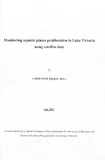| dc.description.abstract | Abstract
This work reports the monitoring of aquatic plants proliferation in Lake Victoria using
satellite data over the period 2003 to 2010. The lake, which is the second largest freshwater
body in the world and an important economic resource, is facing serious environmental
challenges including growth of invasive plants. The role of some selected water quality
parameters as well as meteorological conditions in aquatic plants proliferation is also
investigated. Multispectral MERIS (Medium Resolution Imaging Spectrometer) imagery,
were obtained from ESA in the framework of TIGER Initiative. Images were selected on the
basis of spatial and temporal coverage, spatial and spectral resolution and the severity of
cloud cover. Atmospheric correction was carried out as pre-processing procedure to improve
on the image interpretability. The images were processed using BEAM 4.8 and ENVI4.2
image processing and analysis software. Image derived endmembers were used to classify the
images using linear spectral unmixing classification technique. Temporal variation of
vegetation was obtained, and the spatial distribution was presented by cover maps. Mapping
was done using ArcGIS 9.3. TSM and Chl-a values were retrieved from the images using
MERIS Eutrophic Lakes Processor 1.4.1 while rainfall data was obtained from Kenya
Meteorological Department (KMD). Spectral unmixing technique performed well with a
mean classification accuracy of 99.48%, based on RMSE. Most images showed a high
concentration ofChl-a and TSM along the shores of the la.k..•e.-,~especially the Winam Gulf, and »
most of the aquatic vegetation was observed in the sanre regions. Vegetation cover in the
Winam Gulf which was kept below 100 km2 during the years 2003 to 2006 increased to a
peak of about 200 km2 in 2007, before decreasing again to below 100 km2 during the years
2008 to 2010. Regression results for Winam Gulf show that vegetation abundance has a weak
linear correlation with rainfall, TSM-and Chl-a of R = 0.67 (R2 = 0.44), R = 0.46 (R2 = 0.21)
and R = 0.57 (R2 = 0.32), respectively after a response period of two to three months. From
these relations, vegetation abundance prediction models are proposed. At no time delay,
however, vegetation abundance showed no significant relationship with these parameters,
while TSM and Chl-a are significantly dependent on each other with R = -0.77 (R2 = 0.6).
While traditional methods of monitoring vegetation and water quality parameters is both
expensive and time consuming, remotely sensed satellite data provides reliable, consistent
and repeatable information that is suitable for this study. | en |

